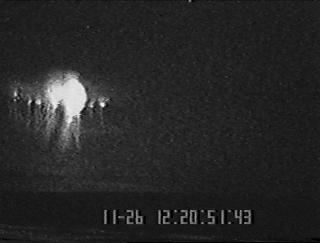
A research team from the University of Otago, Dunedin, New Zealand, working at "Window on the Wetlands" (60 km from Darwin) have captured 72 images of "Red Sprites" on video tape on Wednesday night, 26th November. These red sprites are believed to be produced by an electrical discharge from the top of a thunder cloud (about 10 km altitude) to the base of the ionosphere (90 km altitude). The jellyfish-shaped luminosity usually extends from 50 km to 80 km and so is 30 km from bottom to top and generally about 50 km wide. The dozen or so "jellyfish tentacles" hanging down are only about 1 km in diameter. All of the 72 red sprites observed on 26th November are believed to have occurred above the Wingate Mountains, about 250 km south of Darwin.
Such "Red Sprites" were discovered accidentally on tape from a very sensitive video camera under test in America a few years ago. Until now, the only ground-based video images have been made in the USA, mainly in Colorado, though some have been observed from the Space Shuttle. The Otago team, lead by Professor Dowden, had previously established a link between very long wavelength (15 km) radio echoes and red sprites in Colorado and deduced that such radio echoes recorded in the Darwin area during the last Wet season (1996/97) meant that luminous red sprites must occur above the Northern Territory also.
Although this is the first proved (video imaged) sighting of red sprites from the ground outside the USA, such red sprites must have occurred above NT every Wet season for millions of years. They rarely last more than a tenth of a second and are generally faint, but some - certainly one and maybe up to nine of the 72 caught on video on Wednesday night - can be seen by the naked eye if one is well away from city lights and looking in the right direction. Such red sprites must surely have been seen by the Aboriginal peoples in the past, particularly before modern man polluted the night sky with artificial lighting. Is there an oral tradition of such sightings?
The Otago team (Richard Dowden, John Bahr, Simon Hardman
and James Brundell) are indebted to the Department of Parks and Wildlife
for the use of Window on the Wetlands as an observatory and to Professor
Zen Kawasaki of Osaka University, Japan, who is currently in Darwin researching
lightning and lent a sensitive video camera for this purpose.

Photograph of the video screen. The jellyfish-shaped
luminosity (top left) extends from 50 km altitude at the bottom to 80 km
(260,000 feet) at the top. The side to side width is about 50 km (30 miles).
The dozen or so jellyfish tentacles" hanging down are only about 1 km in
diameter. The numbers in white give the date and time in GMT to a hundredth
of a second. In NT local time this is 9:50 pm.